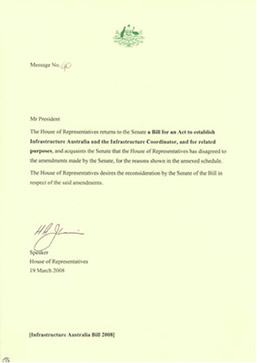132 Disagreement with Senate amendments
-
If the House of Representatives returns a bill with amendments made by the Senate disagreed to, or further amendments made, the message returning the bill shall be printed and a time fixed for taking it into consideration in a committee of the whole.
-
Where the House of Representatives:
-
disagrees to amendments made by the Senate; or
-
agrees to amendments made by the Senate with amendments,
the Senate may:
-
insist, or not insist, on its amendments;
-
make further amendments to the bill consequent upon the rejection of its amendments;
-
propose new amendments as an alternative to the amendments to which the House of Representatives has disagreed;
-
agree to the House of Representatives amendments on its own amendments, with or without amendment, making consequent amendments to the bill if necessary;
-
disagree to those amendments and insist on its own amendments which the House of Representatives has amended; or
-
order the bill to be laid aside,
and, unless the bill is laid aside, a message shall be sent to the House of Representatives advising of the Senate’s action.
Amendment history
Adopted: 19 August 1903 as SOs 227 and 228 (corresponding to paragraphs (1) and (2)) but renumbered as SOs 226 and 227 for the first printed edition
1989 revision: Old SOs 236 and 237 combined into one, structured as two paragraphs and renumbered as SO 132; language modernised and expression streamlined
Commentary
Like SOs 126 and 127 in respect of Senate bills, this standing order provides the machinery for dealing with disagreements to Senate amendments to bills originating in the House of Representatives. The options it contains provide maximum flexibility in reaching agreement with the House on a bill. In particular, and in contrast with SO 127, there is no limit on the number of times a bill may travel between the Houses in order to resolve a disagreement.

A message from the House of Representatives indicating that the House has disagreed with amendments made by the Senate to a bill which originated in the House
Paragraph (1) deals with the timing and mode of consideration by the Senate of a message from the House disagreeing with Senate amendments or making further amendments to a bill. Paragraph (2) lists the options available to the Senate in responding to a disagreement with, or further amendments to, the Senate’s amendments. Unless the bill is laid aside, the action taken by the Senate is reflected in the terms of the message back to the House, for example:
The Senate does not insist on its amendments to which the House has disagreed.
The Senate does not insist on its amendments to which the House has disagreed and has made further amendments in their place. The Senate requests the concurrence of the House in the further amendments.
The Senate does not insist on its amendments nos <numbers> to which the House has disagreed and insists on its amendments nos <numbers> to which the House has disagreed. The Senate requests the reconsideration of the bill by the House in respect of amendments nos <numbers>.
The Senate has agreed to the amendments made by the House to Senate amendments nos <numbers> with the further amendments in the annexed schedule. The Senate requests the concurrence of the House in the further amendments made by the Senate to the amendments made by the House.
The Senate again insists on its amendments to which the House has disagreed. The Senate requests the reconsideration of the bill by the House in respect of the amendments.